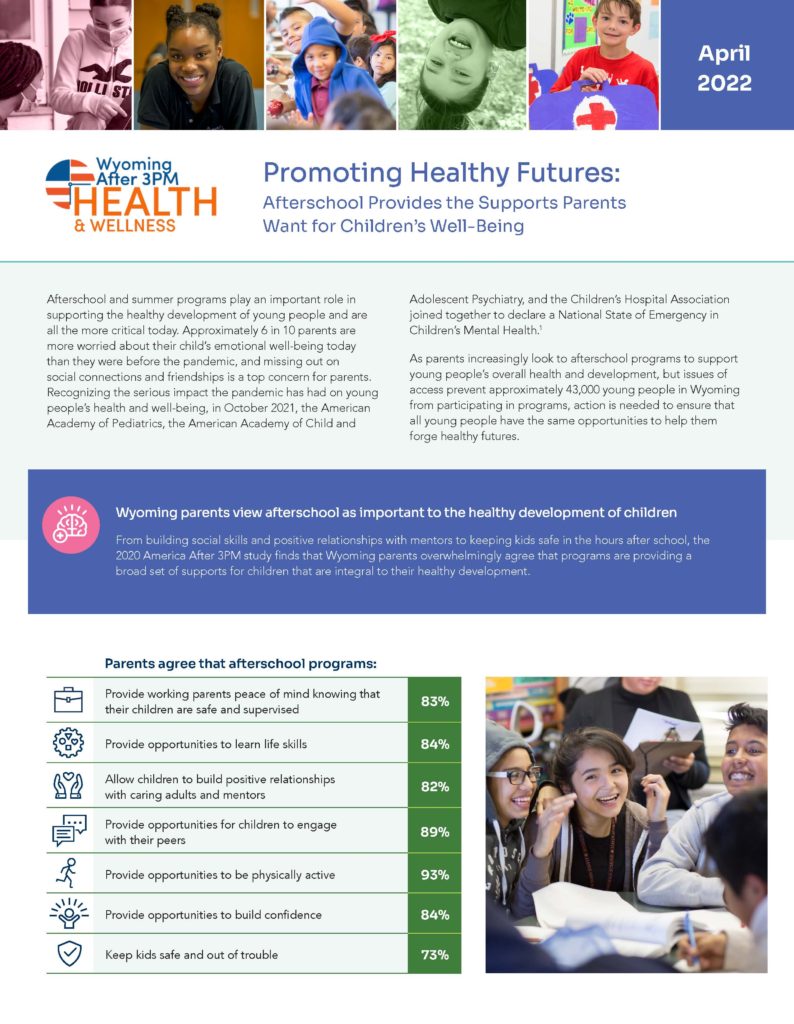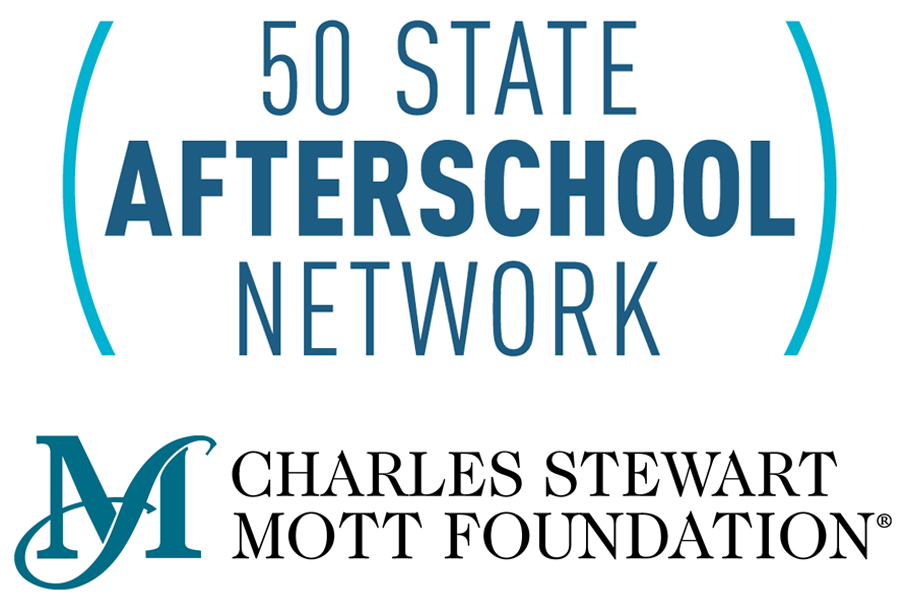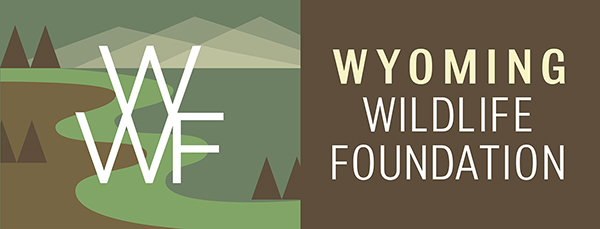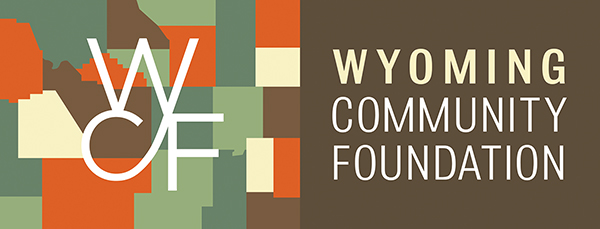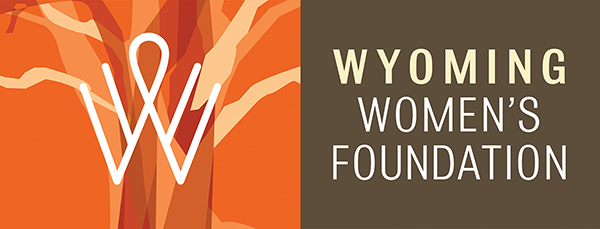WYOMING AFTER 3PM
Promoting Healthy Futures: Afterschool Provides the Supports Parents Want for Children’s Well-Being
Most Wyoming parents see afterschool programs as part of the solution to the social and mental health struggles so many students are experiencing right now, with 8 in 9 saying these programs give students time to engage with peers and reduce unproductive screen time, and 5 in 6 saying they help build confidence.. Learn more about Wyoming After 3PM below. For national information, visit afterschoolalliance.org/AA3PM.
As Many Youth Cope with Anxiety and Depression, Wyoming Parents Recognize that Afterschool Programs Support Recovery and Wellness
 Most Wyoming parents see afterschool programs as part of the solution to the social and mental health struggles so many students are experiencing right now, with 8 in 9 saying these programs give students time to engage with peers and reduce unproductive screen time, and 5 in 6 saying they help build confidence. That is according to Promoting Healthy Futures: Afterschool Provides the Supports Parents Want for Children’s Well-Being, a household survey released today by the Afterschool Alliance.
Most Wyoming parents see afterschool programs as part of the solution to the social and mental health struggles so many students are experiencing right now, with 8 in 9 saying these programs give students time to engage with peers and reduce unproductive screen time, and 5 in 6 saying they help build confidence. That is according to Promoting Healthy Futures: Afterschool Provides the Supports Parents Want for Children’s Well-Being, a household survey released today by the Afterschool Alliance.
Afterschool programs are especially important now, as the country faces a youth mental health crisis. In December, the U.S. Surgeon General issued a sobering warning about the mental health of America’s youth, warning that rates of anxiety, depression, and sadness rose dramatically during the pandemic.
The Centers for Disease Control and Prevention (CDC) just reported that 4 in 10 high school students report feeling “persistently sad or hopeless” and 1 in 5 have contemplated suicide. The CDC noted that “school connectedness” is a protective factor for youth facing mental health challenges.
The household survey the Afterschool Alliance released today includes responses from more than 31,000 U.S. parents of school-age children, including 252 in Wyoming. It was conducted by Edge Research in 2020. It shows that parents see afterschool and summer learning programs as a pivotal support young people need. Eighty-two percent of Wyoming parents of afterschool students report the program helps their child learn responsible decision-making and 96% report it helps their child build positive relationships with caring adults and mentors.
“Here in Wyoming, afterschool programs have been stepping up to meet the challenges students and families are facing by checking in with students during remote learning, taking students on virtual and actual field trips, providing counseling and other supports, helping students to find agency through entrepreneurship and the Wyoming Young Entrepreneur Pitch Challenge, and more,” said Michelle Sullivan, Director of the Wyoming Afterschool Alliance. “We are pleased that this study finds that large majorities of Wyoming parents recognize the tremendous supports that out-of-school-time programs provide. But we need to do even more to ensure that all students in Wyoming have access to these programs. Right now, the unmet demand is great.”
“Afterschool and summer learning programs offer critically important opportunities for students to engage with their peers, learn life skills, and build positive relationships with caring adults and mentors,” said Afterschool Alliance Executive Director Jodi Grant. “But too many young people are missing out. For every child in an afterschool program in our country today, three more are waiting to get in. The families of 24.6 million children — more than ever before — are unable to access a program. There are significant inequities, with Black and Latino children among those most likely to be unable to access the afterschool programs their parents want for them. We need to make it possible for all students to participate in afterschool programs, which help them build the resilience, hope, and connectedness they need to succeed.”
Download the Full Press Release
Download the Fact Sheet
Spiking Demand, Growing Barriers: The Trends Shaping Afterschool and Summer Learning in Rural Communities
NEWS RELEASE CONTACT: Lisa Lederer December 8, 2021 202/421-5825
New Report Finds Unmet Demand for Afterschool Programs in America’s Rural Communities Rising Sharply
Rural Students of Color and from Low-Income Families Most Likely to Miss Out
WASHINGTON, DC — Just 11% of America’s rural children are enrolled in an afterschool program. For every rural child in an afterschool program, four more are waiting to get in. That’s an even higher ratio than in the country overall, where for every child in an afterschool program, three more are waiting to get in. Spiking Demand, Growing Barriers: The Trends Shaping Afterschool and Summer Learning in Rural Communities, released today, also finds that 92% of rural parents are satisfied with the afterschool program their child attends, up from 85% who were satisfied in 2014.
Some 4.5 million rural children who are not in an afterschool program would be enrolled if a program were available, their parents say. That is a 43% increase since the study was last conducted in 2014. Rural children of color and rural children from families with low incomes are most likely to be without the afterschool programs their parents want for them. The unmet need for summer learning programs has also surged in rural communities.
Spiking Demand, Growing Barriers is based on a household survey conducted by Edge Research for the Afterschool Alliance. It finds a drop in rural children enrolled in afterschool programs from 13%, or 1.19 million rural kids, enrolled in 2014 to just 11%, or 1.15 million kids, enrolled in 2020. The drop mirrors national trends on afterschool participation as public funding for afterschool programs has not kept up with demand. The new study finds that cost and transportation are significant barriers that prevent many rural parents from enrolling their child in an afterschool program.
“The inequities in terms of access to afterschool and summer learning programs are profoundly troubling,” said Afterschool Alliance Executive Director Jodi Grant. “More than 46 million people in this country live in rural communities, where one in five residents are people of color and poverty is higher than in urban and suburban communities. Out-of-school-time programs boost children’s chance to succeed in school and in life but too often rural students are shut out of the opportunities these essential programs provide.”
“Increasing access to both afterschool and summer learning programs must be an urgent priority for lawmakers and funders,” Grant continued. “We need to invest many more resources so that all students, regardless of the size of their community or their family’s race or income, can access this support. As we emerge from the pandemic, afterschool and summer learning programs will be even more critical in helping children learn, feel safe and cared for, and strengthen their social and emotional health.”
Spiking Demand, Growing Barriers is based on survey responses from more than 31,000 U.S. families, including 9,690 rural households. It includes national-level findings from smaller surveys of parents and program providers conducted in 2020 and 2021, also by Edge Research. Among the key results:
- A growing number of parents in rural communities face barriers to afterschool. Fifty-five percent of rural families cite cost as a barrier to enrollment in 2020, compared to just 40% who said that in 2014. Fifty percent cite not having a safe way to and from the afterschool program as a barrier to enrollment, compared to 36% who said that in 2014. And 45% cite lack of available programs, compared to 29% who said that in 2014.
- Rural communities of color and rural families with low incomes have the highest levels of unmet demand for afterschool programs. While 47% of rural parents overall whose child is not in an afterschool program say they would have liked to enroll her or him, that figure is 59% for rural Black parents; 57% for rural Latino and rural Asian American, Native Hawaiian and Pacific Islander parents; and 52% for rural low-income parents.
- Rural student enrollment in summer learning programs is growing, but still not nearly meeting the demand. In 2008, 20% of rural parents reported having a child who participated in a summer program. That figure rose to 28% in the summer of 2013 and 38% in the summer of 2019. But still, today, for every rural child in a summer learning program, two more are waiting to get in. Thirty-five percent of rural parents whose child is not enrolled in a summer program say that cost was an important factor in their decision not to enroll their child, and one in five said a program was not available in their community.
- Cost is lower for rural programs and offerings more scant. The average weekly cost for afterschool programs as reported by rural parents is $69.30, compared to a national average of $99.40 and an average for families living in non-rural communities of $106.90. Summer programs, too, cost less in rural communities. Rural students are spending less time in their afterschool programs now than in the past. Fewer rural than urban and suburban parents report that their child’s afterschool program offers science, technology, engineering and math (STEM), although more rural parents report programs are offering STEM now than in the past. Today, 70% of rural parents report that their child’s afterschool programs offer STEM learning, compared to 66% in 2014.
- Rural afterschool programs have stepped up during the pandemic to support students and families. In early July of 2020, more than half of rural afterschool program providers reported that their program was serving as a meal site, delivering meals, or distributing resources to families. By the summer of 2021, 84% of rural programs were physically open in some capacity with more than 9 in 10 providing academic enrichment, outdoor activities, and time for students to interact with peers and two-thirds providing snacks or meals. Thirty-seven percent of rural programs reported having a wait list this spring and 45% had a wait list this summer.
- Strong majorities of rural parents support public funding for afterschool and summer learning programs. Eighty-six percent of rural parents support public funding for afterschool in communities that have few opportunities for children and youth; and 86% of rural parents support public funding for summer learning opportunities.
The new study includes a series of recommendations. Among them: grow public awareness about the need for more afterschool programs in rural communities through concerted outreach; improve the accessibility of afterschool programs in rural communities; conduct more research to better understand the views about afterschool programs among rural parents of color; and increase overall support for rural afterschool programs.
Findings in Spiking Demand, Growing Barriers: The Trends Shaping Afterschool and Summer Learning in Rural Communities are based on America After 3PM, a nationally representative survey of randomly selected adults who live in the United States and are the parent or guardian of a school-age child who lives in their household. A total of 31,055 households, including 59,983 children, were surveyed in English or Spanish between January 27 and March 17, 2020. Nearly 10,000 respondents (9,690) reported that they live in a “rural area/small town.” The overall margin of error for child-level and household-level data is +/- < 1 percent. Data were collected by Edge Research.
Spiking Demand, Growing Barriers: The Trends Shaping Afterschool and Summer Learning in Rural Communities was supported by the Walton Family Foundation. The 2020 America After 3PM survey was made possible with support from the New York Life Foundation, Overdeck Family Foundation, The Wallace Foundation, the S.D. Bechtel, Jr. Foundation, Altria Group, and the Walton Family Foundation, as well as the Charles Stewart Mott Foundation.
The full study, America After 3PM, and accompanying data, are available at www.afterschoolalliance.org.
# # # #
The Afterschool Alliance is a nonprofit public awareness and advocacy organization working to ensure that all children and youth have access to quality afterschool programs. More information is available at www.afterschoolalliance.org.
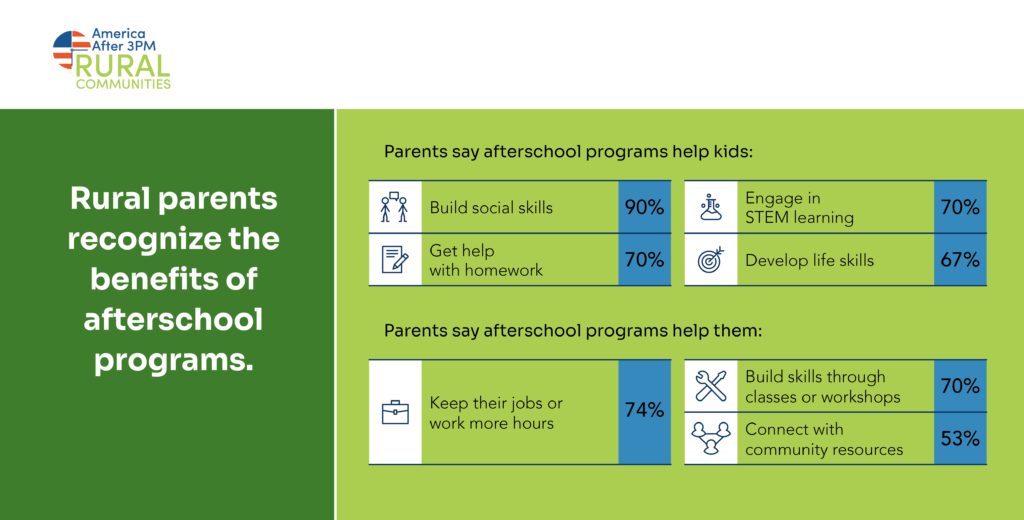
STEM Learning Opportunities Being Offered by More Wyoming Afterschool Programs, But Nationwide, Students from Low-Income Families Have Less Access, New Study Finds
August 18, 2021 | NEWS RELEASE CONTACT: Matt Freeman, 301-758-3279
WASHINGTON, DC — With demand for well-trained STEM (science, technology, engineering and math) workers expected to skyrocket, and women and people of color grossly underrepresented in STEM professions, afterschool programs in Wyoming and across the country have been ramping up their STEM offerings. Today, 48% of Wyoming parents report programs are providing STEM, up from 39% in 2014. Sixty percent of parents nationally and 47% in Wyoming report that their child participates in STEM in afterschool twice or more per week. Learning opportunities in each of the STEM disciplines – science learning, technology and engineering, and math – are more available in afterschool programs nationwide today than they were in 2014. Two in five parents (41%) report that their child’s afterschool program offers computer science opportunities – a question asked for the first time in this survey.
Those are among the findings from STEM Learning in Afterschool on the Rise, But Barriers and Inequities Exist, a household survey conducted by Edge Research for the Afterschool Alliance and released today. In total, 7,112 Wyoming students and 5,740,836 students nationwide are getting STEM learning opportunities in their afterschool programs.
But while afterschool programs are reaching populations underrepresented in STEM fields, including Black and Latinx students, students from low-income families are much less likely to be getting technology/engineering and computer science activities in afterschool than students from higher-income families nationwide. That may be, in part, due to cost; parents across the country report the mean cost of programs offering STEM learning is $107 per week, compared to $74 per week for programs that do not offer it.
“Afterschool programs are uniquely positioned to provide the STEM learning opportunities students need to succeed in school and in life,” said Afterschool Alliance Executive Director Jodi Grant. “Thanks to the team-based, hands-on learning these programs provide, they have become a cornerstone of STEM learning for children and youth from all backgrounds. But the inequities are troubling. We need to build more partnerships and invest more resources to ensure that all students, no matter their family income, gender, or race, can access STEM in afterschool. And we need to increase access to afterschool overall, because even though a greater percentage of programs are providing STEM, fewer children are in afterschool programs today than in years past. That trend is alarming.”
“Our programs here in Wyoming have been doing heroic work during the pandemic, helping students who have been dealing with stress and uncertainty for more than a year,” said Michelle Sullivan, Director of the Wyoming Afterschool Alliance. “Many programs provided STEM learning before and during the pandemic. We are pleased to see that a growing number of parents recognize the importance of STEM learning in afterschool. But we know there is more work to do. We are determined to find ways to increase resources and engage new partners so that all Wyoming families have the afterschool programs. they need and all children and youth get STEM in their afterschool programs. We are particularly proud of our partnership with STEM Next and the Million Girls Moonshot, which is inspiring and preparing the next generation of innovators by engaging one million more girls nationwide in STEM learning opportunities through afterschool and summer programs over the next five years.”
- STEM Learning in Afterschool is based on responses from more than 31,000 U.S. families, including 252 families in Wyoming. It includes national-level findings from smaller surveys of parents and program providers conducted in summer and fall of 2020 and spring of 2021. In important respects, Wyoming results mirror the national survey findings, which include:
- Parents strongly support STEM learning in afterschool. Three out of four parents nationally, and 82% in Wyoming say that afterschool programs help children gain interest and skills related to STEM. Seventy-two percent of parents across the country say STEM and computer science learning opportunities were important in choosing an afterschool program for their child, up from 53% in 2014. In Wyoming, 57% of parents say that today.
- STEM learning opportunities are widely available in afterschool and summer learning programs. Today, nationally, 73% of parents report that their child’s afterschool program offers STEM learning opportunities, up from 69% in 2014. Among the STEM disciplines, the greatest jump is in technology/engineering activities, which were offered by 30% of afterschool programs in 2014 and 39% today. Nearly 2 million U.S. children (1,904,846) participated in summer STEM camps in 2019, including 1,545 children in Wyoming.
- Afterschool programs provide STEM learning opportunities to populations underrepresented in STEM fields. Nationally, more parents of Black (77%) and Latinx (77%) students report that their child’s afterschool program offers STEM than White (72%) and Asian (68%) parents. Afterschool STEM opportunities have increased for both boys and girls since 2014, rising from 69% in 2014 to 75% for boys and 72% for girls today.
- But opportunities are not the same for all families. Nationally, three in five children in families with higher incomes (62%) participate in a STEM activity in their afterschool program twice per week or more, but just 56% of children in families with low incomes do. Students in families with higher incomes also have a greater variety of STEM offerings, particularly in technology/engineering, science, and computer science.
- There are gender disparities in the students afterschool and summer learning programs reach with STEM. Although afterschool STEM opportunities have increased for both boys and girls, opportunities are growing faster for boys. Nationally, STEM learning opportunities in afterschool increased from 69% in 2014 to 75% for boys, while increasing from 69% to 72% for girls. Nationally, 53% of STEM summer camp participants are boys and just 47% are girls.
The national and Wyoming America After 3PM reports, and accompanying data, are available at www.afterschoolalliance.org.
This 2021 America After 3PM special report, STEM Learning in Afterschool, is based on research commissioned and funded by Overdeck Family Foundation. Data from this special report is based on the 2020 America After 3PM survey results, which was made possible with support from the New York Life Foundation, Overdeck Family Foundation, The Wallace Foundation, the S.D. Bechtel, Jr. Foundation, Altria Group, and the Walton Family Foundation, as well as the Charles Stewart Mott Foundation.
# # # #
This 2021 America After 3PM special report, STEM Learning in Afterschool, is based on research commissioned and funded by Overdeck Family Foundation. Data from this special report is based on the 2020 America After 3PM survey results, which was made possible with support from the New York Life Foundation, Overdeck Family Foundation, The Wallace Foundation, the S.D. Bechtel, Jr. Foundation, Altria Group, and the Walton Family Foundation, as well as the Charles Stewart Mott Foundation.
# # # #
The Afterschool Alliance is a nonprofit public awareness and advocacy organization working to ensure that all children and youth have access to quality afterschool programs. More information is available at www.afterschoolalliance.org.
Findings from Stem Learning in Afterschool are based on a nationally representative survey of randomly selected adults who live in the United States and are the parent or guardian of a school-age child who lives in their household. A total of 31,055 households, including 59,983 children, were surveyed in English or Spanish. Data from interviews is weighted on race and income within states and by state population. The overall margin of error for child-level and household-level data is +/- < 1 percent. The survey included at least 200 interviews in every state and the District of Columbia. Data was collected between January 27 and March 17, 2020, by Edge Research.
Download the Factsheet
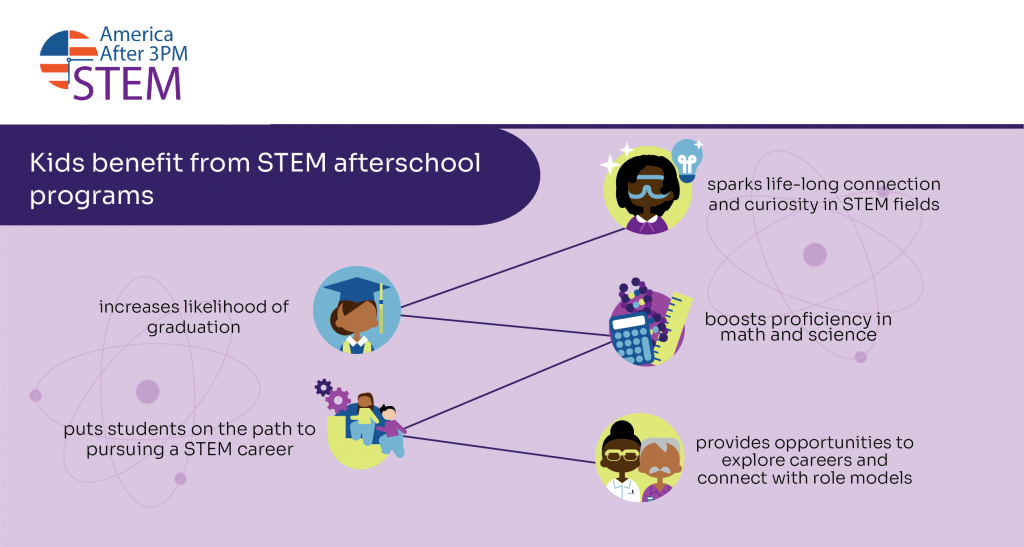
Wyoming parents praise summer learning programs but, even before COVID-19, programs were out of reach for many Wyoming children.
May 19, 2021 | NEWS RELEASE CONTACT: Matt Freeman, 301-758-3279
WASHINGTON, DC — After a year of isolation, learning loss, and trauma for many students, this summer will be especially important for young people to begin to heal, re-connect, and make learning gains. Yet a study released today finds that even before the pandemic, some 18,083 Wyoming children and youth were without access to summer learning programs. This was 24% of Wyoming children not in a summer program whose parents wanted to enroll them.
Time for a Game-Changing Summer, With Opportunity and Growth for All of America’s Youth, a household survey commissioned by the Afterschool Alliance and conducted by Edge Research, finds that nearly half of families nationally (47%) and 36% in Wyoming report at least one of their children participated in a summer program in 2019. A total of 12.6 million students – or 22% of the country’s K 12 children – participated in a structured summer experience in 2019, as did 20,106 Wyoming children, or 21% of the state’s K-12 kids. An overwhelming majority of parents are satisfied with their child’s summer learning program.
The study also finds high unmet demand nationally, with children in low-income families most likely to be left behind. Cost is the barrier to enrollment Wyoming parents cite most often; 32% of those who did not have a child in a structured summer experience in 2019 cited cost as the reason. A structured summer experience is defined to include a summer learning program, sports program, summer camp, summer school, or summer job or internship, but is different from child care.
Participation in summer learning programs dropped significantly in 2020 as the pandemic hit. Just 34% of families across the country had a child in a structured summer experience that year, and many kids who did take part participated virtually.
“Summer learning and afterschool providers in Wyoming have been doing heroic work during the pandemic,” said Afterschool Alliance Executive Director Jodi Grant. “This research tells us that unmet need for summer learning programs was a significant problem even before COVID-19 struck. The stakes are even higher now, with so many of our children needing academic help, social and emotional support, and opportunities to engage with peers and caring adults, be physically active, and more. This summer, all students need access to summer learning programs that allow them to have fun, be kids, and accelerate their learning through enriching hands-on activities. Cost must not remain a barrier to participation. Every student needs an opportunity to engage, heal, learn, and grow this summer.”
“Summer learning programs enjoy extraordinary support from parents, with 95% of Wyoming parents reporting they were satisfied with the structured summer experience their child attended and 81% saying they favor public funding for summer learning opportunities for students in communities with few opportunities for children and youth,” said Michelle Sullivan, Director of the Wyoming Afterschool
Alliance. “Our goal for this summer is to make these essential programs available to all children and youth in Wyoming. Students and families are relying on us to help kids re-engage, address anxiety and learning loss, and re-discover their passion for learning. That’s why we are bringing together businesses, nonprofits, museums, community-based organizations, colleges and universities, and others to help us make summer learning programs more available and even more impactful here in Wyoming this year.”
Time for a Game-Changing Summer is based on responses from more than 29,500 U.S. families, including 241 families in Wyoming. It includes national-level findings from smaller surveys of parents and program providers conducted in summer and fall of 2020 and spring of 2021, offering a snapshot of how children and youth spent their summers before and during the pandemic. In important respects, Wyoming results mirror the national survey findings, which include:
- Unmet demand for summer experiences is high. Nearly 14 million children in the United States whose parents wanted to enroll them did not have access to a summer program in 2019. More than half of families without a child in a summer program report that they would have liked to have had one available to them that year. In 2020, during the pandemic, 48% of families without a child in a summer program would have enrolled their child if a program had been available.
- There are troubling inequities in access to summer programs. While 27% of children in higher-income families participated in a structured summer experience in 2019, just 14% of students in families with low incomes did. Approximately three in four children in a structured summer experience (74%) are from higher-income families, compared to only one in four children (26%) from lower-income families.
- Cost is a barrier to participation. Two in five parents who did not have a child in a structured summer experience (39%) did not enroll their child because programs were too expensive. Among children not enrolled in a summer program, 35% of children in households with low incomes would have been enrolled in a summer program in 2019 if one were available, compared to 28% of children in higher-income households.
- The cost of programs varies by program type and place. The average cost reported by families who pay for activities nationally ranges from around $758 for voluntary summer programs to more than $900 for STEM camps.
- Parents prioritize life skills for summer learning and want the summer experience to be different than the school year. Three in four parents (75%) value keeping their child from losing academic ground in choosing their summer activity, but even more – nine in ten – report that opportunities to build life skills (94%), be physically active (92%), and experience a variety of activities (90%) are important factors in selecting their child’s summer activities.
- Priorities vary by family income. Low-income parents place a greater emphasis on reducing risky behaviors (23 percentage point difference) and snacks and meals (21 percentage point difference) than families with higher incomes.
“Quality afterschool and summer programs are essential to student success in school and life,” Grant added. “Lawmakers recognized that by including significant one-time funding for afterschool and summer learning programs in the American Rescue Plan. States must ensure that funding is well-used. All our children and youth need ready access to enrichment and academic opportunities this summer and during the coming school year. This study shows unacceptable levels of unmet need, especially for low-income families. This summer we have a responsibility to meet the need – and when we do, children and youth, families, communities, and our country will be stronger.”
The national and Wyoming America After 3PM reports, and accompanying data, are available at www.afterschoolalliance.org.
This 2021 America After 3PM special report, Time for a Game-Changing Summer, is based on research commissioned and funded by The Wallace Foundation as part of its mission to foster equity and improvements in learning and enrichment for young people, and in the arts for everyone by supporting and sharing effective ideas and practices. Data from this special report is based on the 2020 America After 3PM survey results, which was made possible with support from the New York Life Foundation, Overdeck Family Foundation, The Wallace Foundation, the S.D. Bechtel, Jr. Foundation, Altria Group, and the Walton Family Foundation, as well as the Charles Stewart Mott Foundation.
# # # #
The Afterschool Alliance is a nonprofit public awareness and advocacy organization working to ensure that all children and youth have access to quality afterschool programs. More information is available at www.afterschoolalliance.org.
Findings from Time for a Game-Changing Summer are based on a nationally representative survey of randomly selected adults who live in the United States and are the parent or guardian of a school-age child who lives in their household. A total of 29,595 households, including 53,287 children, were surveyed in English or Spanish and answered questions regarding the summer of 2019. Data from interviews is weighted on race and income within states and by state population. The overall margin of error for child-level and household-level data is +/- < 1 percent. The survey included at least 200 interviews in every state and the District of Columbia. Data was collected between January 27 and March 17, 2020, by Edge Research.
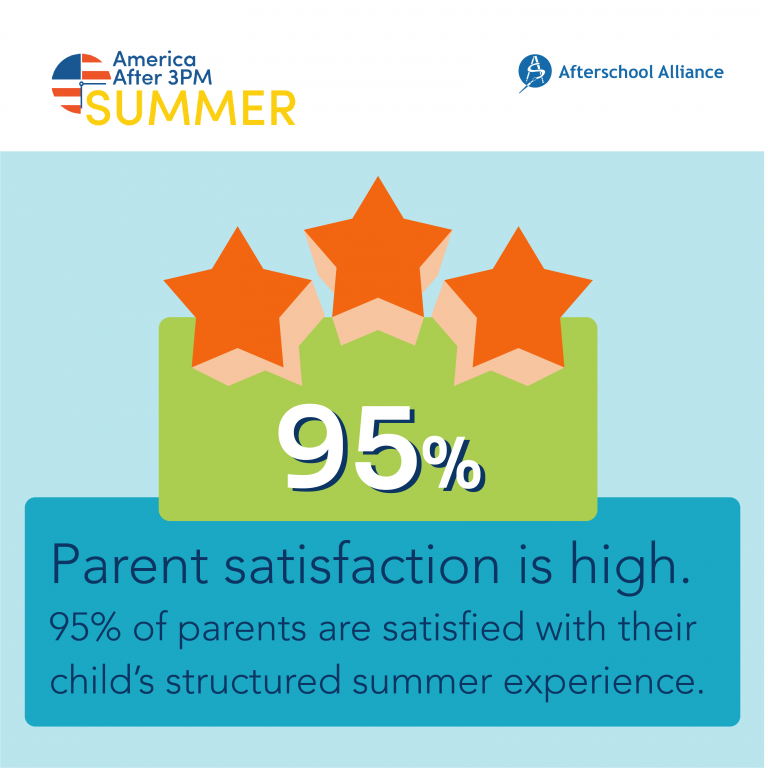
Wyoming Parents Give Afterschool High Marks, Household Survey Finds Huge Unmet Demand
December 8, 2020 | NEWS RELEASE CONTACT: Matt Freeman, 301-758-3279
WASHINGTON, DC — Many more Wyoming parents want afterschool programs for their children than are able to access them, according to a household survey commissioned by the Afterschool Alliance and released today. It finds that, by overwhelming margins, parents express strong, broad-based support for afterschool programs. But unmet demand – the percentage of children in Wyoming not currently in an afterschool program whose parents say they would be enrolled if an afterschool program were available to them – has increased over the past six years, with low-income families in particular citing cost as a barrier to enrolling their children. As a result, for every child in an afterschool program in Wyoming today, three more are waiting to get in.
America After 3PM 2020 is based on survey responses from more than 30,000 American households, including 252 in-depth interviews in Wyoming. It was completed before the coronavirus pandemic struck. It finds that 15% of Wyoming students, 14,719 children and youth in all, are enrolled in afterschool programs, showing no progress since 2014, when the survey was last conducted. In addition, 43,230 Wyoming students are without the afterschool programs their parents say they need today.
“Afterschool providers and advocates in Wyoming are doing remarkable work, but the state is still not coming close to meeting the demand for these programs,” said Afterschool Alliance Executive Director Jodi Grant. “Most parents in the state who want their child in a program can’t find one. We need to fix that. Every parent should have access to an affordable, quality afterschool program that will keep their child safe, supervised and learning. Quality afterschool programs are essential to student success in school and life. If we want to emerge from this pandemic strong, we need to provide all our children and youth access to the important enrichment opportunities and resources afterschool programs provide.”
“While we are incredibly pleased that parents express such strong support for the afterschool programs their children attend, we recognize the urgent need to broaden opportunity and make afterschool programs available to many more children and youth here in Wyoming,” said Michelle Sullivan, Director of the Wyoming Afterschool Alliance. “America After 3PM 2020 finds that 91% of parents are satisfied with the afterschool program their child attends. We are also encouraged that 80% of Wyoming parents express their support for public funding for afterschool programs. That’s a strong foundation to build on. Students and families need afterschool programs now more than ever, since the pandemic has changed school schedules, disrupted our economy, and put many children and youth at risk. We are calling on lawmakers, businesses and others to recognize afterschool as an important part of our workforce infrastructure and help us make afterschool programs more available to students and families here in Wyoming right away.”
In important respects, Wyoming results mirror the national survey findings, which include:
- Support for afterschool programs is strong. Parents give high marks to afterschool programs, with 83% agreeing programs give working parents peace of mind, 81% agreeing programs help parents keep their jobs, and 76% agreeing programs help children gain interest and skills in STEM – all increases from 2014.
- Unmet demand for afterschool programs is soaring. Demand has grown 60% since 2004, from 15.3 million children (30% of non-participants) waiting to get into a program in 2004 to 18.4 million children (38%) in 2009 to 19.4 million children (41%) in 2014 to 24.6 million children (50%) in 2020.
- Cost and access are barriers to participation, and inequities persist. Sixty-one percent of low income parents report that cost is a barrier to enrolling their child in an afterschool program. Access (lack of a safe way for their child to get to and come back from a program) is a barrier for 58%. Both are significant increases from 2014.
- Just 7.8 million children are enrolled in an afterschool program today, down from a high of 10.2 million children in 2014. The inequities in terms of which students are accessing programs are stark. The number of children from low-income households participating in afterschool fell from 4.6 million in 2014 to 2.7 million in 2020, while the number of higher income children in afterschool fell by just under 450,000 over the same period.
- The number of elementary school students on their own after school rose slightly to more than 850,000, an increase of almost 38,000 since 2014, while the number of unsupervised middle and high school students dropped from 2014 to 2020.
- Eighty-seven percent of parents favor public funding for programs that provide afterschool opportunities to students in communities that have few opportunities for children and youth. Support crosses demographic and political divides, with 91% of parents who identify as Democratic, 87% of those who identify as Independent, and 85% of parents who identify as Republican in favor of public funding.
“During the pandemic, in Wyoming and around the country, afterschool programs have been stepping up to meet the growing needs of students and families, even as programs face higher costs, dwindling budgets, and uncertain futures themselves,” Grant added. “Nationally, half of afterschool programs that are serving students in person, and are located in school districts that are operating virtually, have wait lists. We must do better. Publicly funded afterschool programs have been a lifeline for low-income children. We need to bring more federal, state, local, business and philanthropic support to meeting the needs of students and their families after school.”
The national and Wyoming America After 3PM 2020 reports, and accompanying data, are available at www.afterschoolalliance.org.
Findings from America After 3PM 2020 are based on a nationally representative survey of randomly selected adults who live in the United States and are the parent or guardian of a school age child who lives in their household. A total of 31,055 households were surveyed in English or Spanish, and a subset of households (14,391 respondents) answered follow-up questions regarding afterschool experiences or barriers to participation in afterschool, as well as perceptions of afterschool programs. Data from interviews are weighted on race and income within states and by state population. The overall margin of error for child-level and household level data is +/- < 1 percent. The survey included at least 200 interviews in every state and the District of Columbia. Data were collected between January 27 and March 17, 2020, by Edge Research.
The October 2020 survey of parents was conducted by Edge Research and is a nationally representative online survey fielded October 12-29, 2020, of 1,202 parents of school-aged children.
America After 3PM 2020 is made possible with support from the New York Life Foundation, Overdeck Family Foundation, The Wallace Foundation, the S.D. Bechtel, Jr. Foundation, Altria Group, the Walton Family Foundation, and the Charles Stewart Mott Foundation.
# # # #
The Afterschool Alliance is a nonprofit public awareness and advocacy organization working to ensure that all children and youth have access to quality afterschool programs. More information is available at www.afterschoolalliance.org.
Download the Factsheet
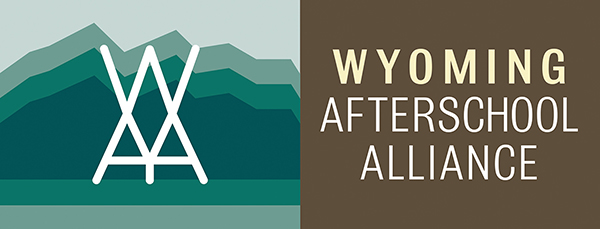
Mission: We bridge the gap between Wyoming’s out-of-school programs and the communities they uplift, fueling them with resources, support and opportunities that inspire lifelong learning, growth and connection.
Sign up to get news and updates delivered to your inbox.
